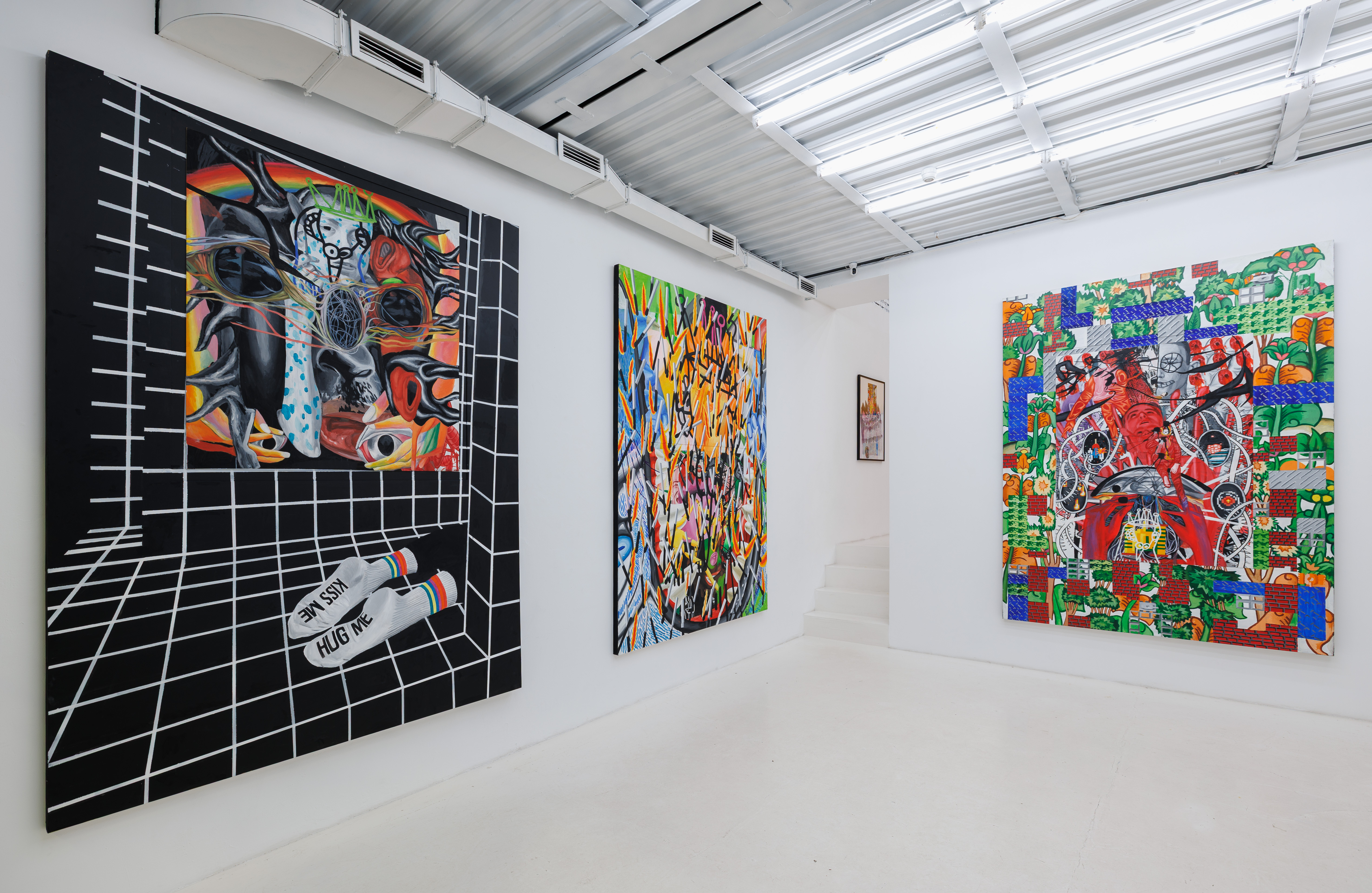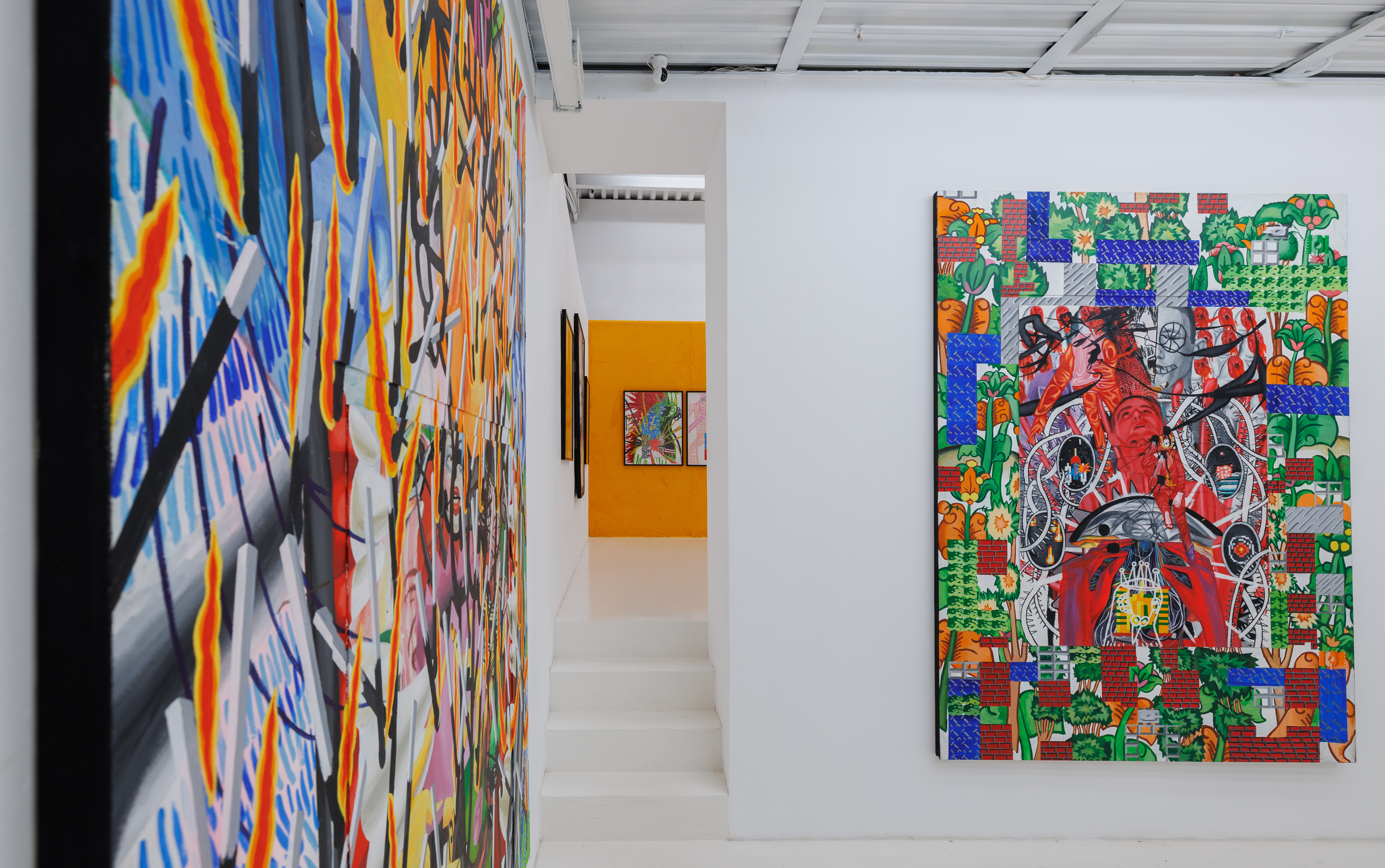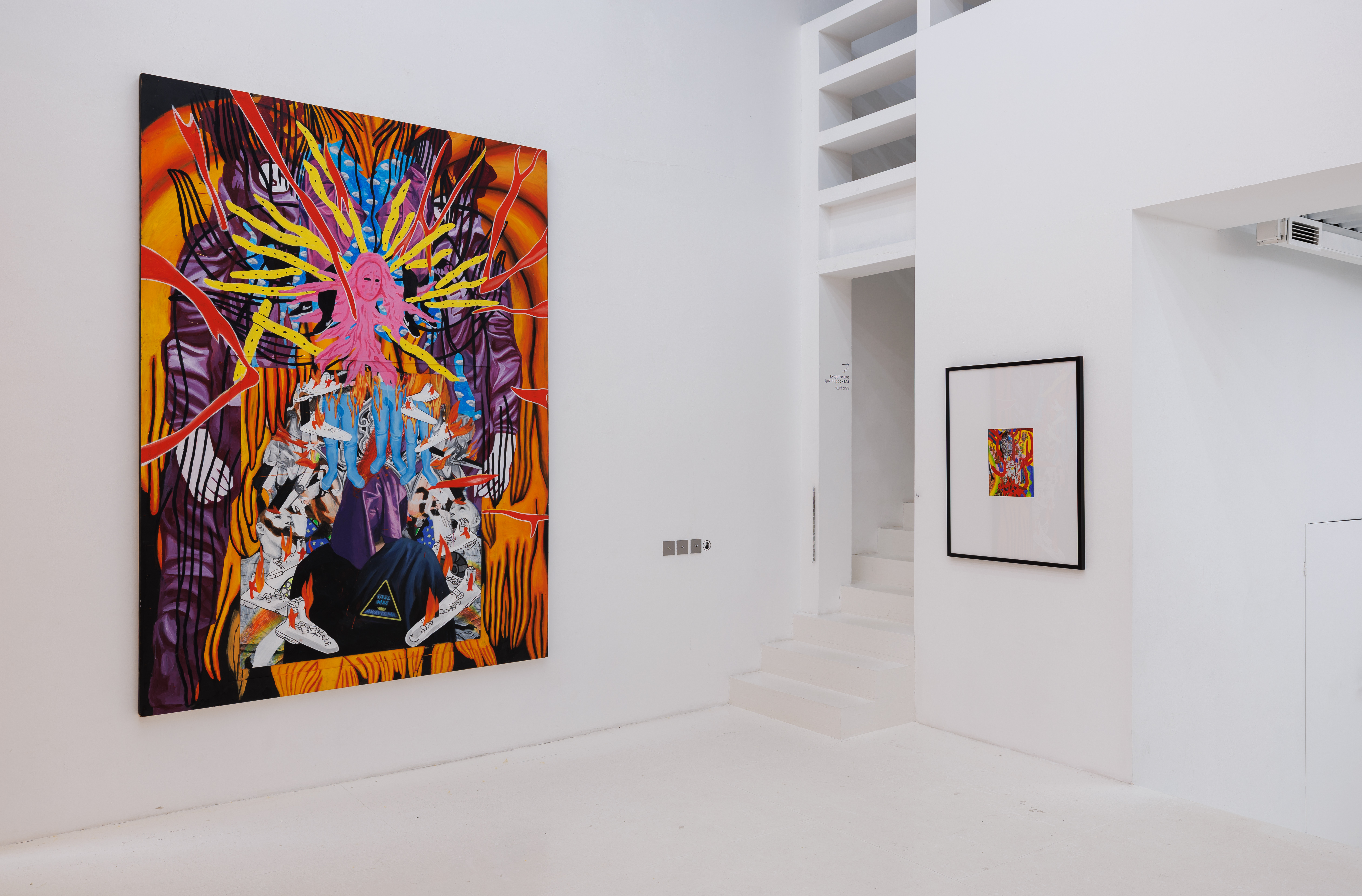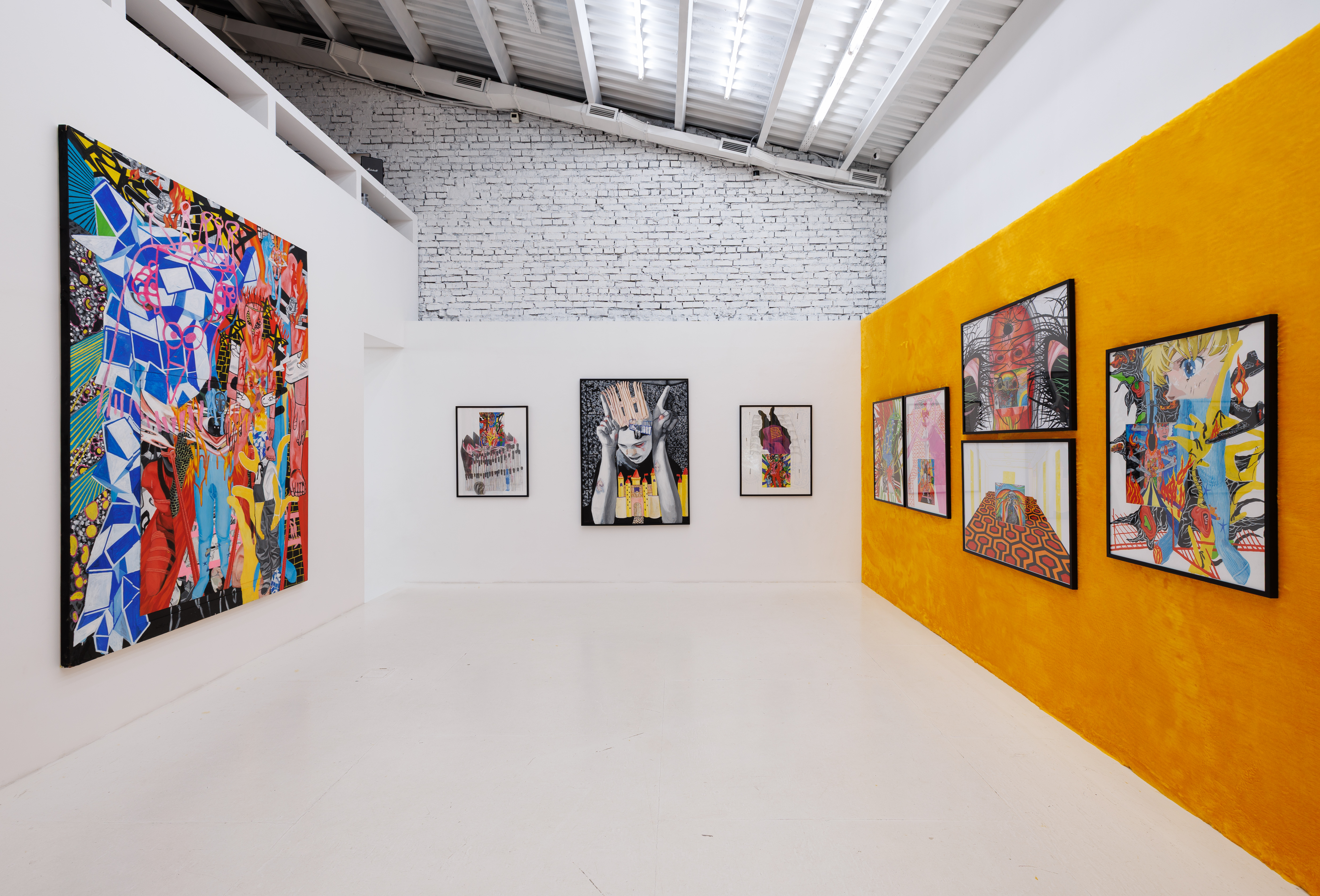Yellow Notebook
solo show by Alexander Kupalyan
Winzavod Contemporary Art Center, entrance H8
11.03 — 13.04.2025
18+
On March 11, the a—s—t—r—a gallery of contemporary art hosted the opening of Alexander Kupalyan's personal exhibition "Yellow Notebook". This project, created jointly by the a-s-t-r-a gallery and Shkulev Holding, continues the main line of both institutions in supporting contemporary artists and marks the multifaceted cooperation of various players in the contemporary art market. The curator of the exhibition was Dmitry Hvorostov. A special issue of the philosophical magazine "Logos" dedicated to decadence and hedonism was prepared especially for the exhibition, and an extensive public program was developed in Moscow and St. Petersburg.
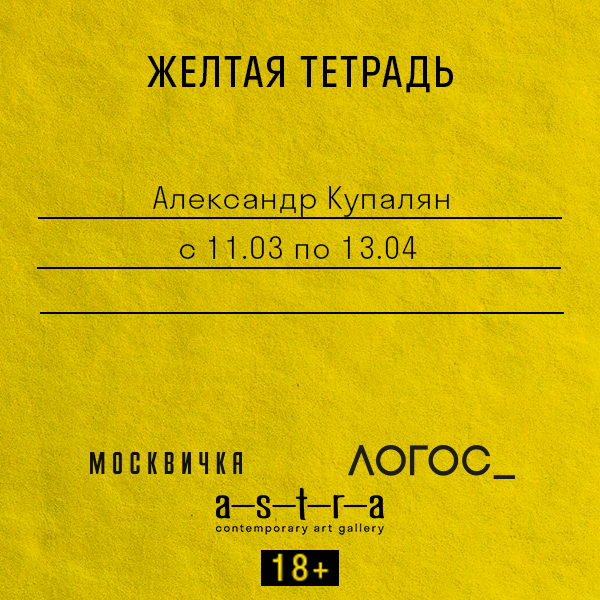
LOGOS "HEDONISM AND DECADENCE"
As part of the personal exhibition of Alexander Kupalyan, together with the a-s-t-r-a gallery, an issue of the leading Russian philosophical magazine "Logos" was prepared on the topic of "Hedonism and Decadence". Philosophers, cultural scientists and social researchers discuss the nature of hedonism and decadence in different societies and times. Among the authors of the issue are Svetlana Voloshina, Ivan Mikirtumov, Polina Khanova, Alexander Pogrebnyak, Alexander Vileykis, Sergey Fokin and others. Continuing the reflections that the artist's exhibition begins, the issue shows the relationship between the social and decadence/hedonism.
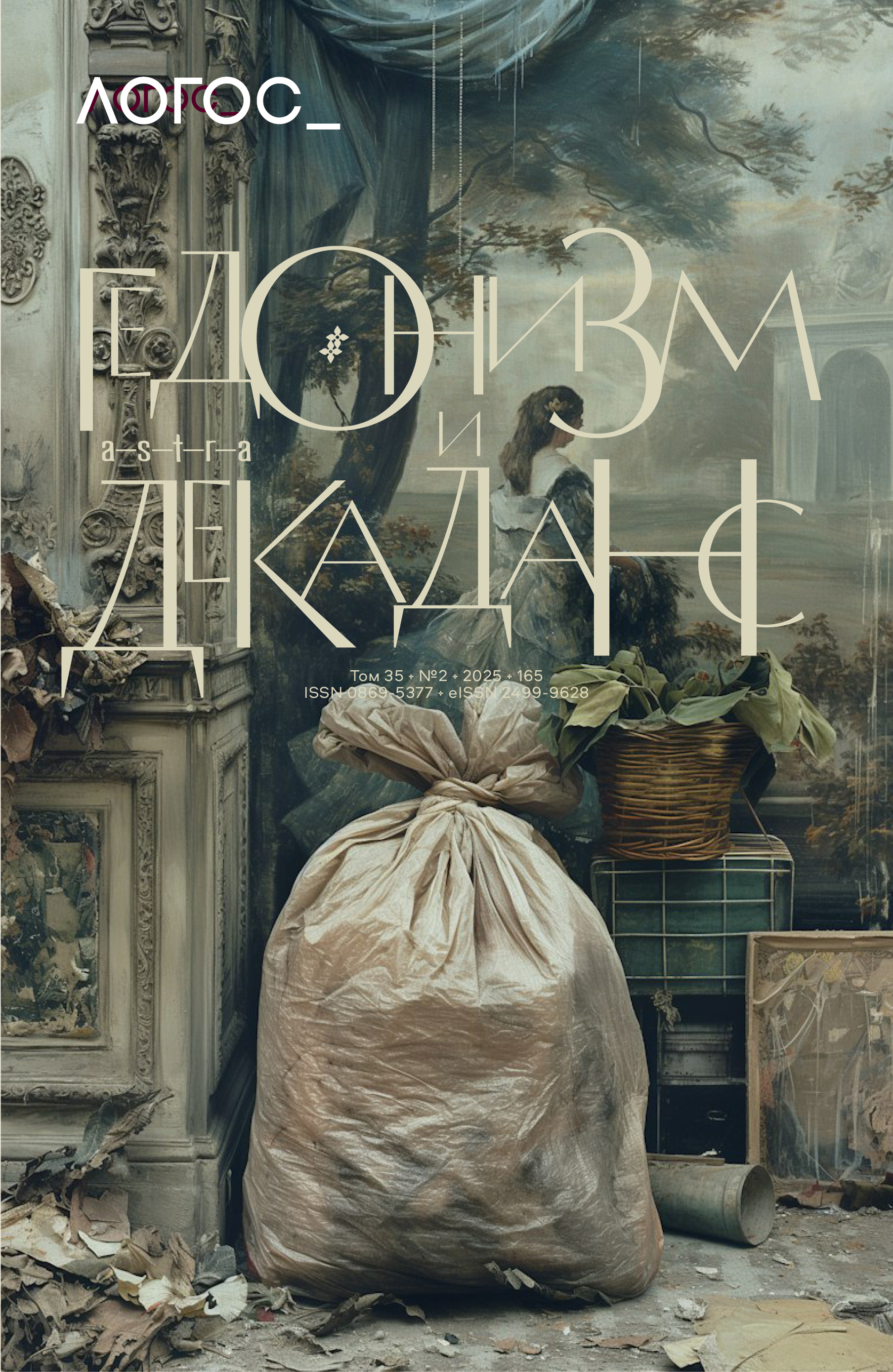
PUBLIC PROGRAM
- March 15, 17:00 Gallery a—s—t—r—a – public presentation of the Logos magazine issue – “Hedonism and Decadence”: Valery Anashvili, Ivan Mikirtumov. Alexander Pogrebnyak, Alexander Vileikis, Polina Khanova
- March 29, 17:00 Gallery a—s—t—r—a – public lecture by Svetlana Voloshina dedicated to decadence in the Russian Empire
- April 12, 16:00 Gallery a—s—t—r—a – public lecture by Vadim Veterkov dedicated to dandyism as a form of decadence REGISTRATION
"I prefer books with yellow covers"
Mrs. Cheveley from Oscar Wilde's play "An Ideal Husband" is a vivid example of a character who combines charm, ambition, and immorality. Her image serves as a tool with which Wilde reveals the paradoxes of Victorian England and the contradictory moral imperatives of the era. Mrs. Cheveley utters a phrase that is not immediately clear today: "I prefer books with yellow covers" - a phrase that is worth dwelling on in more detail.
The yellow cover as an element of book design appeared in Europe in the 19th century and acquired special significance in the context of the literary culture of that time. In Paris at the end of the 19th century, yellow began to be associated with literature that caused a public outcry or was considered inappropriate. Books with frank content, immoral plots, or provocative philosophical ideas were often wrapped in yellow dust jackets - a kind of warning to the reader and at the same time a signal to those interested. This practice reflected the duality of society’s attitude towards such works: on the one hand, it marked them as something risky and forbidden, on the other, it emphasized their appeal to sophisticated readers looking for intellectual or aesthetic provocation. Books by Emile Zola, Joris-Karl Huysmans, and Gustave Flaubert were published in yellow covers. In England at the end of the 19th century, yellow acquired a new meaning thanks to the magazine “The Yellow Book,” designed by Aubrey Beardsley. This publication became a symbol of the decadence and aestheticism movement, and its yellow cover became a sign of belonging to the artistic and literary opposition to traditional tastes and morals. Thus, the yellow cover became a cultural code containing a challenge to society, a symbol of intellectual freedom.
Yellow has remained a polysemantic symbol in European art for centuries, transforming along with the changing cultural and social context. In the Middle Ages, it was often associated with divine light, holy radiance, decorating the halos and nimbuses of saints in icons and frescoes. However, yellow could also have a negative meaning: Judas Iscariot was often depicted in yellow robes, turning the color into a marker of betrayal. Yellow was also used to denote characters associated with illness or misfortune. For example, in some village legends, yellow was associated with plague or fever, and those who wore yellow clothes were considered potential carriers of disasters. In some cultures, yellow was used to denote deception and cunning. It is worth remembering the image of a fox - a symbol of a cunning creature. In German and Scandinavian legends, dwarves and gnomes were often depicted in yellow or golden robes. In some Slavic and Eastern European fairy tales, witches could wear yellow clothes, symbolizing a connection with dangerous, destructive forces. In European fairy tales, werewolves or demons could be endowed with yellow eyes. In folk beliefs in various European countries, yellow was associated with ill health, especially fever or jaundice. For example, "yellow clothes" could be worn by people who escaped the plague but remained isolated.
By the 19th century, yellow had acquired a more subjective character, becoming an expression of the artist’s inner world. For Vincent van Gogh, this color was a tool for conveying tension, passion, and loneliness. In the 20th century, yellow became a carrier of anxiety and protest. For example, Egon Schiele used it to emphasize the fragility of the human body, and Otto Dix added it to his works as a symbol of destruction and decline.
In political history and heraldry, yellow symbolized both nobility and warning. In medieval coats of arms, yellow (gold) represented wealth, glory, and generosity. It was an attribute of royal power, a symbol of sunlight and divine favor. But at the same time, as in art, its ambivalent nature allowed the color to be interpreted as a sign of betrayal or warning. For example, in some European traditions, yellow in a coat of arms could be associated with suspicion or envy.
With the development of political symbolism, yellow acquired a more utilitarian meaning. It has become a color that warns of danger and boundaries, which is especially noticeable in modern infrastructure: road signs, fences, high-visibility vests. In this context, yellow acts as a universal code of attention, combining the attraction of the eye with a sense of anxiety.
Yellow was also often used to symbolize exclusion or humiliation. An example of this is the mandatory use of yellow signs to identify Jews in medieval Europe, which found a tragic continuation in the 20th century in the form of the yellow Star of David in Jewish ghettos during the Third Reich. These practices linked yellow with the image of stigmatization, social or ethnic alienation.
Returning to the "Yellow Book", it is worth saying that the deliberate provocative position of the editors and authors associated with the magazine had tragic consequences. Society was not ready to put up with the moral hooliganism inherent in this circle. The magazine was indirectly involved in a trial known as the Oscar Wilde affair. It is believed that Wilde was holding a copy of the magazine in his hands when he was arrested (1895), which attracted additional attention to the magazine and caused a wave of criticism and pressure, as a result of which the editorial group disintegrated. Another important element that underlines the character of the era is that Wilde's artistic works were used as evidence of his moral crimes in his trial. This fact clearly highlights the problematic and traumatic nature of the aestheticism and decadence movement, which insisted on the artistic autonomy of "art for art's sake".
Aestheticism and Decadence
Aestheticism and decadence are two key concepts of the late 19th and early 20th centuries that largely determined the development of European art and literature. These terms embodied the idea of a radical rejection of the utilitarian function of art and the assertion of its autonomy. As Oscar Wilde wrote in the preface to The Picture of Dorian Gray, "all art is useless." This statement became the manifesto of aestheticism, proclaiming art to be the highest value, existing outside of ethical and social constraints.
Aestheticism was closely associated with the cult of beauty and an attempt to find solace in sophistication and refined pleasure. This movement expressed a protest against bourgeois taste and mass culture. One of its main apologists was Aubrey Beardsley, who claimed: "The main thing is not the meaning, but the form. Ideal art has neither morality nor immorality." Beardsley, with his unique graphic style and outrageous approach, turned each work into a provocation.
The emergence of the mass press, photography and other forms of popular culture was perceived as a threat to high art. Aestheticism became a kind of elite response, opposing the masses with exquisite sophistication, complex allusions and the cult of individual beauty. As Wilde wrote: "Beauty is the only thing worth living for."
Decadence inherited the principles of aestheticism, but supplemented them with an exploration of the crisis of modern man. Writers and artists of decadence - Charles Baudelaire, Stéphane Mallarmé, Joris-Karl Huysmans, Arnold Böcklin, Franz von Stuck - delved into themes of decline, death and spiritual isolation. Decadence, unlike aestheticism, gravitated towards the dark sides of human nature, exploring destruction and decline as aesthetic categories.
One of the most striking aspects that defined the aesthetics of decadence, according to Mario Pratz, an Italian literary historian, is the discovery of a profound connection between eroticism and the theme of death. In his book Romantic Agony (1933), Pratz analyzes how the artistic and literary traditions of the late 19th century turned these concepts into key elements of self-expression and philosophical reflection: “Death becomes the greatest erotic fantasy, since it completes earthly pleasure, turning it into an eternal idea. In this fusion, eroticism acquires an existential meaning, linked to the inevitability of death.” The philosopher who had the strongest influence on the intellectual environment of this time is undoubtedly Friedrich Nietzsche. Despite his criticism of decadence, his ideas of undermining morality (Beyond Good and Evil, 1886) inspired all those who identified with decadence and sought to create new aesthetic and moral systems based on pleasure, individualism and the cult of beauty. His famous idea of "revaluation of all values" became one of the key slogans for artists and writers of the late 19th century.
The image of fin de siècle - the end of the century - became a symbol of the end of an era. This time was characterized as decline and at the same time preparation for a new, unknown future. Artists and poets of decadence perceived this period as a transitional one, requiring a rethinking of human existence through the prism of aesthetic and philosophical crisis.
Aestheticism and decadence throughout the 20th century in the form of concepts and consonant ideas spread throughout the territory of art studies. It cannot be said that this century was a triumph of these concepts; rather, they walked on the edge, entering into various semantic constructions, colored in the tones of retromania. In post-war art, pragmatism, expediency, social and political engagement, the discourse of benefit and responsibility began to win. World wars, information surplus, mass culture, ideological catastrophes - all this radically influenced the structures of imagination and the politics of sensuality. Historical decadence today seems too refined, and the position of aestheticism excessively conservative. However, nothing prevents us from turning to them, reinventing them, rewriting their meanings.
There are no losers
Alexander Kupalyan's "Yellow Notebook" galvanizes the theoretical body associated with aestheticism and decadence, but does so in passing, at a distance, not wanting to get stuck in the viscous swamp of historicism. For the modern viewer, such a symbolic exhumation is nevertheless capable of establishing a primary focus on what is happening in Alexander's works.
When we first started working on the exhibition, the idea was outlined very roughly. Although Alexander's works of recent years can be linked by a common mood, plots and creation techniques, for me the question "Where are we moving?" remained unresolved for a long time. In many ways, this is due to the specifics of the work - Alexander almost never has a clear plan of action when starting work on a new painting. The images that appear on the canvas begin to argue and displace each other. Something disappears without a trace, leaving only a barely noticeable relief under new layers of paint. The canvas becomes a notebook, a sketchbook for sketches and quick recording of visual impressions. But unlike a pencil sketch, which, as a rule, remains transparent, a light hint of the future form, the “notebook” of Alexander, who works quite quickly, is rapidly filled with full-color dense volumes, expansively conquering the entire space of the canvas. High information density of the canvas is achieved already at the first approach, and the work may seem finished, but its subsequent transformations almost always completely change the composition, color perspective and plot. Moreover, this transformation is repeated more than once. Alexander works on several works simultaneously, living with them, living in them, constantly changing their identity. Such an emphasis on process in the work is confusing, especially if you try to grab onto some kind of narrative hook and pull a story out of the work. During the preparation of the exhibition, we spent many hours in conversations with Alexander. They talked about his academic background and classical art, which, as some now think, stands on immovable canons, but there is a parallax hidden in this issue. Everything that has managed to take root in the past receives the stamp of structure and statics. And the dynamics of formation disappears or, at least, delicately retreats under the pressure of the raging elements of the life of the modern viewer. This paradox is the quasi-academic nature of Alexander's painting. In the dispute with tradition, inherent in many modern artists, one can discover the hypnotic work of the tradition itself. Modernisms, adopted in the form of acts of rebellion, suffer defeat in most cases, and in those in which they retain their strength, they themselves become hostages of the historical unfolding of this tradition. And here it is no longer important what moral intonation we give to this unfolding. The appearance of this or that image on Alexander's canvas is always justified in the act of the artist's introspection. Alexander, discussing the structure of personality, notes its nature, which is not controlled by reason. Man turns out to be a passive receiver of information and impressions. Reflexive work on reorganization of mental space is sporadic, and the tools with which this work is carried out also accidentally fell into our hands, and the ability to use them causes justified skepticism. Nevertheless, the structures that arise in this way take root quite firmly in our mental landscapes. Architectural ensembles arise, erected by unidentified engineers. And the artist has to work with this, who is doomed to fall into mental landscapes that form what is commonly called by the short word "I".
Alexander talks a lot about the autonomy of the creative act, without making loud statements in the spirit of Wilde or Beardsley. Nevertheless, it is these authors who act as positive authorities who opened up the self-sufficiency and independence of art to the imagination. Of course, the demand for the autonomy of art is a sly and cunning thing. To understand this demand literally means to seriously mistake the authority from which this demand comes. Suffice it to say that there is a huge political charge hidden here. It is always necessary to take into account the circumstances that lead to such a demand. The demand for autonomy is a rebellion against an imposed value dictate. Wilde would hardly have protested against the dictatorship of emancipation. But this is not certain. It is difficult to conceive of a demand for freedom in an absolutely empty space. There is always something that insistently limits us or pushes us in a specific direction. A Berlin artist close in spirit to Alexander, Jonathan Meese, vividly expressed this problem in his art, arguing that the only thing that can resist the dictatorship of ideology is the dictatorship of art. This opens up the prospect of a rather unpopular discussion about the need for restrictions. Alexander himself raises this issue, saying that red lines, forbidden topics, restrictions are extremely important for an artist, since they are capable of generating a lot of energy. Alexander even talks about the need for some functional anger, which can be used as fuel for the creative act. It is important to clarify that this is not about socially committed artistic practices, but rather about mental charging that produces the effect of physical charging. Overcoming restrictions in Alexander's creative act can be compared to training in a gym, aimed at expanding the capabilities of the body. In place of anger, I would rather put figures of cheerfulness and cruelty to oneself. The positive and even constitutive role of restrictions for an artist is known to many authors who reflect on their work, right up to the genuine gratitude to the camp experience in the assessment of his creative destiny by the artist Boris Sveshnikov.
Returning to the results of Alexander's artistic experiments - to his works, it is worth saying that the imagery opens up many entry points into the works: patterns from computer games, futuristic surfaces, characters from popular culture, fashion, advertising expressiveness of objects. Even the compositional solution of the paintings with the chaotic influx of some volumes onto others accurately reproduces the current situation of information surplus, but not so much visual as symbolic. The rhizomatic syntax of the composition allows us to capture the phenomenological plane of distributed sensuality, for which the "I" as a point of experience assembly becomes more and more blurred. Interest in marginal figures in Kupalyan's art - sects, criminals, dubious visionaries - has a residual connection with Russian literary psychologism and the assertion of moral paradoxes. This is where the symbolism of the yellow color, its semantic ambivalence, and signal nature come into play. In search of his own “I”, the artist consciously turns to the borderline, dark sides of the soul, exaggerates them, testing his own limits of what is acceptable. At the same time, Alexander is aware of the risk he takes, noting the danger of losing his personality in the dark corners of the psyche. Thus, creativity becomes a chronology of a journey along his own boundaries, a risky balancing between two chasms: the abyss of normality and the abyss of madness. Nevertheless, the described existential tension in Kupalyan’s works is masterfully hidden behind an abundance of bright metaphorical images. The striking force of the canvases is close to the New York type of painting. Such painting is characterized by a certain non-obligation, feigned playfulness, ease, color saturation and sharpness of contrast. You can stand next to Alexander’s works and share social gossip, no one will feel awkward in this case. In the end, it’s just a game in which there are no winners or losers.
— Dmitry Hvorostov, curator
